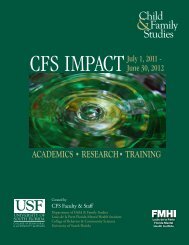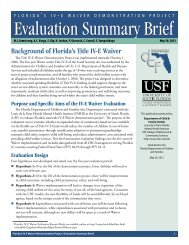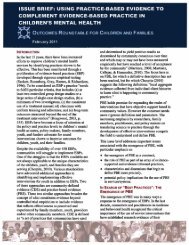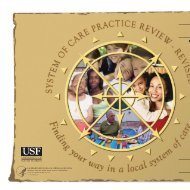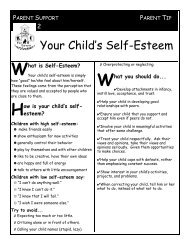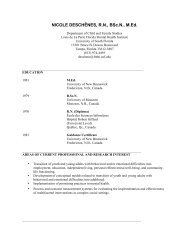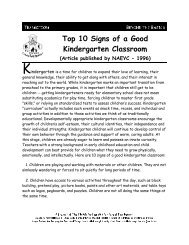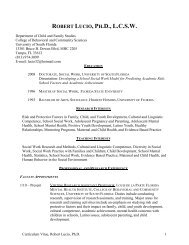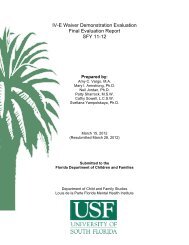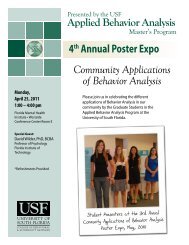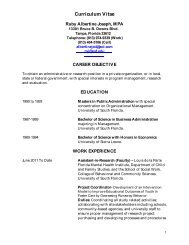The Early Learning Opportunities (ELO) Act - Child & Family Studies
The Early Learning Opportunities (ELO) Act - Child & Family Studies
The Early Learning Opportunities (ELO) Act - Child & Family Studies
Create successful ePaper yourself
Turn your PDF publications into a flip-book with our unique Google optimized e-Paper software.
Evaluation of the <strong>Early</strong> <strong>Learning</strong> <strong>Opportunities</strong> <strong>Act</strong><br />
<strong>Child</strong>’s Name:<br />
Appendix B: Screening for <strong>Early</strong> Literacy <strong>Learning</strong> (SELL)<br />
Screening for <strong>Early</strong> Literacy <strong>Learning</strong> (SELL)<br />
Ages 6 months to 5 years<br />
Home Language:<br />
Date of Birth:<br />
Please place a check mark under each statement that applies to this child.<br />
Date Form Completed:<br />
Example:<br />
Likes ice cream Takes a daily nap Has a sibling Enjoys outside play Watches T.V. at home<br />
<br />
No<br />
communication<br />
<strong>Child</strong><br />
vocalizes<br />
in play<br />
<strong>Child</strong> uses<br />
jargon speech<br />
and/or single<br />
words<br />
<strong>Child</strong> has<br />
vocabulary of<br />
20 or more<br />
words<br />
<strong>Child</strong> is<br />
combining<br />
2-3 words<br />
Communication Skills<br />
<strong>Child</strong> is able<br />
to ask<br />
questions<br />
<strong>Child</strong> can carry<br />
on a<br />
conversation with<br />
peers and adults<br />
<strong>Child</strong> is able to answer<br />
“wh” questions (who,<br />
what, where, why)<br />
<strong>Child</strong> can<br />
tell a story<br />
in sequence<br />
<strong>Child</strong> is able to<br />
predict what will<br />
happen next in<br />
the story<br />
Never looks at<br />
books<br />
<strong>Child</strong> mouths<br />
books like a<br />
toy<br />
<strong>Child</strong> turns<br />
pages of book<br />
<strong>Child</strong> holds<br />
book upright<br />
<strong>Child</strong> looks<br />
at pictures<br />
in a book<br />
Reading<br />
<strong>Child</strong> points<br />
to pictures<br />
as adult<br />
reads<br />
<strong>Child</strong> names<br />
pictures in book<br />
<strong>Child</strong> pretends to<br />
read some words<br />
<strong>Child</strong> notices<br />
when adult<br />
leaves out<br />
words in story<br />
<strong>Child</strong> reads<br />
isolated<br />
words<br />
No letter<br />
recognition<br />
Recognizes<br />
common logo,<br />
like<br />
McDonald’s<br />
Recognizes<br />
own name<br />
Recognizes<br />
others’ names<br />
Recognizing letters<br />
Recognizes<br />
up to 10<br />
letters<br />
Recognizes<br />
up to 20<br />
letters<br />
Recognizes all<br />
letters of<br />
alphabet<br />
Reads 1-3 words Reads 4-8<br />
words<br />
Reads words<br />
with<br />
expression<br />
No<br />
responses to<br />
songs or<br />
rhymes<br />
<strong>Child</strong> vocalizing<br />
while adult sings<br />
or rhymes<br />
<strong>Child</strong> says<br />
some words in<br />
rhyme/song<br />
<strong>Child</strong> recites<br />
rhyme/song<br />
independently<br />
Responses to letter sounds<br />
<strong>Child</strong> can<br />
provide or<br />
identify<br />
rhyming words<br />
<strong>Child</strong> recognizes<br />
some beginning<br />
letter sounds<br />
(Mm for M)<br />
<strong>Child</strong><br />
recognizes all<br />
beginning<br />
letter sounds<br />
<strong>Child</strong> can<br />
sound out<br />
letters in<br />
words<br />
<strong>Child</strong> can<br />
blend<br />
sounds<br />
<strong>Child</strong> able to<br />
sound out a<br />
new word<br />
Louis de la Parte Florida Mental Health Institute, University of South Florida – page 46



